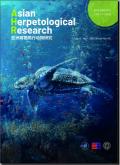中国引种红耳龟与本地龟食性的种间差异
IF 1.2
3区 生物学
Q2 ZOOLOGY
引用次数: 9
摘要
虽然外来的红耳滑龟(Trachemys scripta elegans)通常被认为是一种与本地龟竞争的入侵物种,但关于其饮食的实地证据是有争议的。在广东古田自然保护区和中国海南万泉河沿岸进行的实地研究表明,秀丽隐杆线虫是一种机会性杂食动物,消耗各种各样的食物。消费在其范围内有所不同;广东消耗更多的植物材料,而海南则更多地以肉食为主;幼龙也比成年龙有更多的肉食性饮食。这意味着对新环境有很高的适应能力。海南同域本地毛毛线虫以草食为主,生态位宽度较窄(0.0260),与秀丽隐杆线虫的生态位重叠度较低(0.3048),为入侵的秀丽隐杆线虫提供了潜在的空白生态位。众所周知,红耳滑块还会消耗大量的本地猎物物种,破坏生态平衡。了解该物种的入侵性质及其影响本地生态的机制是当务之急。本文章由计算机程序翻译,如有差异,请以英文原文为准。
Interspecific Differences in Diet between Introduced Red-eared Sliders and Native Turtles in China
Although the alien Red-eared slider (Trachemys scripta elegans) is generally argued as an invasive species that competes with native turtles, the field evidence on its diet is controversial. Field studies conducted at the Gutian Nature Reserve of Guangdong and along the Wanquan River in Hainan, China show that T.s. elegans is an opportunitic omnivore, consuming a wide variety of food items. Consumption varies throughout its range; more plant material is consumed in Guangdong, compared to a more carnivorous diet in Hainan; and juveniles are also found to have a more carnivorous diet than adults. This implies a high adaptability to new environment. Sympatric native Mauremys sinensis shows a more herbivorous diet and a narrower niche breadth (0.0260) in Hainan, plus a low niche overlap (0.3048) with T.s. elegans, providing a potential empty niche for the invasive T.s. elegans. Red-eared slider is also known to consume large quantities of native prey species to disrupt the ecological balance. It is imperative to understand the invasive nature of this species and the mechanisms by which it affects native ecology.
求助全文
通过发布文献求助,成功后即可免费获取论文全文。
去求助
来源期刊

Asian Herpetological Research
ZOOLOGY-
CiteScore
2.80
自引率
7.10%
发文量
441
审稿时长
>12 weeks
期刊介绍:
AHR aims to provide a forum for herpetologists and related scientists interested in conducting international academic exchanges and joint studies, and a platform for introducing their newly made scientific and technological data, and publishing their research results and achievements in the world, but focusing on the Asian-Pacific Region.
The principal criteria of AHR for acceptance of articles for publication are the quality and significance of the research, breadth of interest of the work to the readership, and the clarity and effectiveness of communication. AHR welcomes submission of manuscripts from authors in all countries of the world, though with a focus on the herpetological studies in the Asian and Pacific Region, including major articles, shorter communications and review articles.
 求助内容:
求助内容: 应助结果提醒方式:
应助结果提醒方式:


